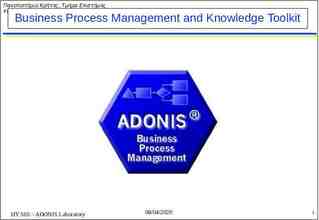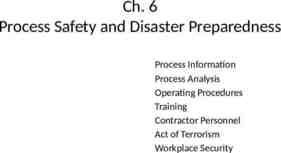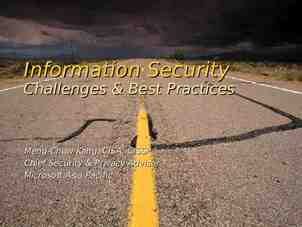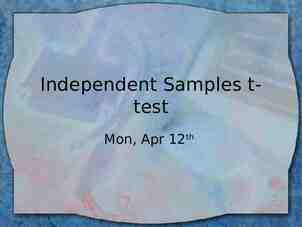Differentiated Instruction and Student Success Empowering Students
34 Slides1,019.00 KB

Differentiated Instruction and Student Success Empowering Students Through the Power of Diversity! Presented by: Dr. Pamela Scott & Dr. Ginger Christian Differentiated Instruction

Our Deepest Fear Our deepest fear is not that we are inadequate, but that we are powerful beyond measure. It is our light, not our darkness, that frightens us. We ask ourselves. Who am I to be brilliant, gorgeous, handsome, talented and fabulous? Actually, who are you not to be? Your playing small does not serve the world. There is nothing enlightened about shrinking so that other people won't feel insecure around you. As we let our own light shine, we consciously give other people permission to do the same. As we are liberated from our fear, our presence automatically liberates others. Williamson Differentiated Instruction Marianne

Essential Questions Why should we differentiate? What are the differences in designing instruction in a traditional schedule and block? How will this support student learning? Differentiated Instruction

National Board Professional Teaching Standards Standard 1: Teachers are committed to students and their learning. Standard 3: Teachers are responsible for managing and monitoring student learning. Differentiated Instruction

Activating Strategy Create a T Chart and answer the following: If I really understand differentiated instruction then I will be able to . If I really do not understand differentiated instruction then I can’t . Differentiated Instruction

Have You Considered? Differentiated Instruction begins with a mindset. A mindset that embraces the opportunity to change so that a student can learn. A mindset that empowers teachers, students, schools, and communities to realize the potential of the individual student and do the work to realize that potential. A mindset that says I, the teacher, will do whatever it takes to see every student I teach become successful. Differentiated Instruction

Differentiation “A teacher’s reacting responsively to a learner’s need” (Tomlinson & Allan, 2000, p. 4). “Is a philosophy that enables educators to plan strategically in order to reach the needs of diverse learners in the classrooms today to achieve targeted standards” (Gregory & Chapman, 2007, p. 2). The goal is to enable the student to reach his or her maximum ability and promote individual success. Differentiated Instruction

Principles that Govern Differentiation Flexible Classroom Flexible grouping - helps ensure students’ success for a wide variety of learning opportunities Instruction stems from effective and ongoing assessment – based on learners’ needs Respectful activities Students and teachers are collaborators in learning Differentiated Instruction

Elements of Curriculum Differentiated Instruction

Elements of Curriculum CONTENT (What) Challenged Average Gifted Three crucial points All aspects of the topic In-depth study Direct instruction and modeling of each step in the research process Modeling &Facilitating Minimal instruction with probing questions for independent study Group paper of one page Five page paper Three concepts PROCESS (How) PRODUCT (Evaluation) Independent work Review and practice Presentation Assessment for Learning Demonstrate Mastery through manipulatives Assessment for Learning and of Learning Differentiated Instruction Power point presentation with computer generated graphics and tables

Assessments for Learning Styles Why is it important to understand the instructional styles of students? Teacher Instructional Styles Teacher Learning Styles Student Learning Styles Differentiated Instruction

How Do I Deliver Instruction? The Grasha-Riechmann Teaching Style Survey Expert - transmits information Formal Authority - structured instruction Personal Model - teach by example Facilitator - consultant, guides students Delegator - assigns task, teacher as a resource Differentiated Instruction

How Do I Learn? How Do My Students Learn? Auditory Learners Benefit most from traditional teaching techniques such as lecture-style forum. Tend to present information by talking - voice tone, inflection, and body language are important to theses learners to maintain their interest and attention. Ensuring success: read aloud, speeches are required, or information is presented and requested verbally. Visual Learners If I can see it, I can learn - Show me don’t tell me. Diagrams, charts, pictures, films, and written directions, to-do lists, assignment logs, and written notes. *Many of these techniques also benefit kinesthetic learners. Kinesthetic Learners Let me build the knowledge through experiences with the concept/skill. Most of the school population excels through kinesthetic means: touching, feeling, and experiencing the material at hand. Differentiated Instruction

Gardner’s Multiple Intelligences It is of the utmost importance that we recognize and nurture all of the varied human intelligences. We are all so different largely because we all have different combinations of intelligences. If we recognize this, I think we will have at least a better chance of dealing appropriately with the many problems that we face in the world. (Gardner, 1983) Differentiated Instruction

Multiple Intelligences Verbal Linguistic Logical Mathematical Visual Spatial Musical Rhythmic Reading Writing Speaking Listening Work well with numbers and abstract patterns Work well with graphic images, mind mapping, graphic organizers Learn best through rhythm, melody, patterned sounds, song, rap, dance Bodily Kinesthetic Interpersonal Intrapersonal Naturalist Process info through touch, movement, drama, manipulatives Sharing Cooperating Interviewing Relating Brainstorming Work alone Self-paced instruction Individualization Metacognitive thinking Spend time outdoors Sorting Classifying Differentiated Instruction Notice patterns in the world

A Moment to Reflect How can you improve your current practices to ensure the success of all the students in your class? http://www.raisingsmallsouls.com Differentiated Instruction

References Gregory, G.H, & Chapman, C.(2006). Differentiated instructional strategies: One size Doesn’t fit all 2nd edition. Thousand Oaks: Corwin Press. Jack, M. (2008). Use of validated learning and teaching assessment tools to Improve resident education. Retrieved from http://asps.confex.com/asps/2008am/techprogram/paper14729.htm Tomlinson, C.A., & Allan, S. D. (2000). Leadership for differentiating schools and classrooms. Alexandria, VA: ASCD. Williamson, M. (2005). You can change the world. Retrieved from http://cholmes.wordpress.com/2005/12/26/our-greatest-fear-is-not-that-we-are inadequate/ Differentiated Instruction

Five Elements of Differentiation Content - Content is differentiated when students spend in-class time working on either accelerated or extended content that moves them ahead in their own learning. Process - Process is differentiated by the methods students use to make sense of what they are learning. Product - Products are differentiated when students are encouraged and allowed to go beyond the written tasks to create actual artifacts, exhibitions, or performances. Learning Environment - The learning environment is differentiated as students interact with others within and outside the classroom, as determined by the content being learned. Assessment - is differentiated when gifted students are allowed to document their mastery of certain standards before that material is taught to the class or when students are allowed to work more quickly than their classmates. Differentiated Instruction

Strategies Compacting and Differentiating Curriculum that Students have already Mastered Most Difficult First Pretests and extensions Learning contracts Differentiated Instruction

Differentiating One Lesson at a Time All students are required to pay attention to direct instruction during the first instructional period—which should be no more than 12-15 minutes. Allow 15-20 minutes for in-class practice Offer the “most difficult first” when you assign some practice items. You indicate which are the most difficult items in the whole assignment and any student who can complete the “most difficult first,” neatly, legibly and accurately (4 out of 5) in 15 minutes is considered finished with the regular work. “Bought” time is for “choice work” (differentiated extension activities) Teachers should only help those students who did NOT choose to do the “most difficult first.” Differentiated Instruction

Pretests and Extensions Compacting and Differentiating One Week at a Time Offer a pre-test for volunteers at the beginning of each unit - those who demonstrate mastery (90% or higher) receive a mastery grade. Those who demonstrate mastery do choice activities (reading, writing, independent study, or extension menus) Differentiated Instruction

Learning Contracts Compacting and Differentiating One Chapter or Unit at a Time Before beginning to teach a new chapter, prepare a learning contract. On the first day of the new chapter, invite all students to survey the standards by looking through the content, page by page. Ask students to notice how much of the content they believe they already know. Show students the pre-assessment. Invite all students who think they could take the pretest today, finish it in 45 minutes, and get a specific number correct to sit in designated areas. Reassure students that it is o.k. to take the test or not and that their grade for the pretest will not be formally counted. Students who already know the required number of concepts will be able to use a Learning Contract throughout the chapter. Differentiated Instruction

Tiered Assignments Each tier interlocks Differentiated Instruction

Assessment Strategies Ask questions that that generate a variety of solutions and stimulate creative thinking Use performance-based tasks and/or activities (e.g., oral presentations, role-playing, paraphrasing, summarizing, retelling, problem-solving situations) Check for understanding by listening closely to what students say Use a variety of informal, formal, and authentic assessments Differentiated Instruction

Formative Assessment “Formative assessment is a process used by teachers and students during instruction that provides feedback to adjust ongoing teaching and learning to improve students’ achievement of intended instructional outcomes.” (CCSSO FAST SCASS, 2006) Differentiated Instruction

Formative Assessment Ongoing assessment Keeps learners on track Gives teachers data necessary to adjust instruction or change any activities that are not challenging enough or perhaps are too challenging Differentiated Instruction

So in other words Formative Assessment Is a process of gathering evidence about students Should guide instruction Should not be done to students; rather, it should be done for and with students, to guide and enhance their learning and to inform the next steps (Partners for Mathematical Learning) Differentiated Instruction

Evaluating Student Work Turn and talk What are some things teachers could learn from examining student work? Differentiated Instruction

Evaluating Student Work All students need feedback on the quality of their work Actionable Feedback Is specific to the learning objectives Describes learning Points students in a productive direction Makes students aware of errors or areas for more thought Provides next steps for specific action (Guskey, T., 2009) Differentiated Instruction

Teacher Leadership and Differentiated Instruction What are the key conditions required for the successful initiation of your school and/or district movement toward differentiation? How will you as a teacher leader help to bring about that change? Differentiated Instruction

An Action Plan Establish a need to articulate the vision Establish common definitions and terms Build understanding and support among stakeholders Link differentiation and best practices Focus district initiatives Attend to competing mandates Plan for leadership and support Allocate financial resources Look ahead to assessing programs Plan for the long haul Differentiated Instruction (Tomlinson & Allan, 2000, p. 51)

Have you considered? After a decade of reform, we have finally learned in hindsight what should have been clear from the start - Most schools and teachers cannot produce the kind of learning demanded by the new reforms - not because they do not want to, but because they do not know how, and the systems in which they work do not support them in doing so Darling - Hammond, 1997, p. 8 Differentiated Instruction

Building for Success What part will you play in building a successful school? Differentiated Instruction

References Darling-Hammond, L., (1997). Doing what matters most: Investing in quality teaching. New York: National Commission on Teaching and America’s Future. Tomlinson, C.A., & Allan, S. D. (2000). Leadership for differentiating schools and classrooms. Alexandria, VA: ASCD. Differentiated Instruction






